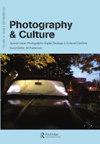Mother, Photography, Reproduction: A Note on Extreme Private Eros : Love Song 1974
IF 0.3
4区 艺术学
0 ART
引用次数: 0
Abstract
AbstractHara Kazuo’s seminal documentary film, Extreme Private Eros: Love Song 1974, actively disturbs presumed boundaries and, in so doing, foregrounds the centrality of performance in documentary filmmaking. While existing scholarship on this documentary focuses primarily on the moving images, in this essay I focus on a series of photographic images inserted in the beginning and examine the impact and workings of photography in the composition of this documentary. The opening photo-sequence proceeds to draw a narrative of the familial relationship existing in the past, facilitating our spectatorial understanding of the personal history of those who are involved in the making of this documentary. At the same time, the photography in the sequence casts its gaze upon us viewers, creating the sensation that we are the ones who are interrogated. As such, the photo-sequence calls on us, pushing us to form a personal relationship with what we see. I contend that the photography in this documentary film engenders a moment for a broader scale of reflection on our own precarity, irrelevance, and non-necessity in the world surrounding Extreme Private Eros.Keywords: PhotographydocumentaryreproductionmotherExtreme Private Eros AcknowledgmentsThe author wishes to express her gratitude to Yanie Fécu and Megan Sarno for their continued support and to two anonymous reviewers for their detailed, constructive comments.Disclosure statementThe author declares that s/he has no relevant interests that relate to what is presented in this article.NoteNotes1 Examples of documentaries laden with socio-political implications include Ogawa Shinsuke's Sanrizuka series and Tsuchimoto Noriaki's Minamata series.2 An example includes the close-up of Takeda's face filmed by Hara when they engage in sexual intercourse. According to Hara's reflection in Camera Obtrusa, the sequence came into being as per Takeda's request: "I want to see what my face looks like while having sex, so I want you to film me" (105–106).3 For this essay, I use a DVD version of the film distributed by Facets Video in 2017. All translations are my own, unless otherwise noted.4 Jun Okada's (Citation2018) study sheds light on the disconnect between local women in Okinawa and Takeda visiting from the mainland, calling the latter's feminist position “mis-guided” (183–186).5 I have in mind, for instance, Annmaria Shimabuku's (Citation2018) book Alegal for the geopolitical contextualization of Okinawa in the 1970s. For women's movements developing in Japan, I owe my understanding to Setsu Shigematsu's (Citation2012) book Scream from the Shadows and Ayako Kano's (Citation2016) Japanese Feminist Debates. Lucy Fischer's Cinematernity gives a helpful insight into genealogies of representations of mothers in (primarily Euro-Anglo-American) films. Book-length analyses of cinematic figurations of mothers in the Japanese context (and beyond) are much needed.6 Nakane Wakae's (Citation2016) work reminds us that Takeda and Kobayashi exercise their agency and thus are integral to the production processes of the documentary. Their involvement in the making of the documentary certainly cannot be ignored. And yet crediting their agency does not destabilize the treatment of subjects as something whole and intact. Subjects in Hara's works are often amorphous and porous, which Hara acknowledges himself when he speaks of his style of self-expression, i.e., bringing to light the self that is yet to be known. I will discuss this point later.7 Okinawa's "reincorporation" in Japan took place in May 1972, three months after the shooting of Extreme Private Eros began in March 1972. In his recollection, Hara explains the embarking on his interest in Okinawa in the early 1970s several times; Okinawa at the time was considered "trendy" (59), "happening" (59), "intense" (99), and "cutting-edge" (99). These references suggest the zeitgeist of mainland Japanese intellectuals and cultural practitioners in the early 1970s.8 According to Hara, Takeda's desire to be recorded when giving birth, unassisted, preceded her move to Okinawa (61, 99–105).9 I borrow the term, "pregnant [suggestive, fruitful, poignant] moment" (78), from Gotthold Ephraim Lessing's meditation on spatial arts.Additional informationNotes on contributorsMiyabi GotoMiyabi Goto is Assistant Professor of Japan Studies in the Department of Modern and Classical Languages, Literatures and Cultures at the University of Kentucky. Goto’s research focuses on the development of modern Japanese literature during and since the Meiji period (1868–1912), with a particular interest in the emergence of criticism as an intellectual practice.母亲,摄影,复制:关于极端私人爱欲的笔记:情歌1974
【摘要】原野一雄的开创性纪录片《极度私人的爱欲:情歌1974》积极地打破了人们的固有界限,从而突出了表演在纪录片制作中的中心地位。虽然关于这部纪录片的现有学术研究主要集中在运动图像上,但在本文中,我将重点放在开头插入的一系列摄影图像上,并研究摄影在这部纪录片的构成中的影响和作用。开篇的一组照片继续描绘了过去存在的家庭关系,促进了我们对参与制作这部纪录片的人的个人历史的观赏性理解。同时,序列中的摄影将目光投向我们观众,创造出我们是被审问的人的感觉。因此,照片序列召唤着我们,促使我们与我们所看到的形成一种个人关系。我认为,这部纪录片中的摄影作品引发了一个更广泛的反思时刻,反思我们自己在围绕极端私人爱欲的世界中的不稳定性、不相关性和非必要性。关键字:摄影纪录片复制母亲极端私人情感感谢作者感谢Yanie f和Megan Sarno一直以来的支持,感谢两位匿名审稿人详细而有建设性的意见。披露声明作者声明他/她与本文所呈现的内容无关。带有社会政治含义的纪录片的例子包括小川新介的《三里冢》系列和土本Noriaki的《水俣》系列其中一个例子是原诚司拍摄的他们性交时武田的脸部特写。根据原诚司在《Camera Obtrusa》中的反映,这个镜头是根据武田的要求产生的:“我想看看我做爱时的脸是什么样子,所以我想让你拍下我”(105-106)在本文中,我使用了facet Video在2017年发行的电影DVD版本。除非另有说明,所有的翻译都是我自己的Okada君(Citation2018)的研究揭示了冲绳当地女性与武田大陆游客之间的脱节,称后者的女权主义立场“被误导”(183-186)例如,我想到了Annmaria Shimabuku (Citation2018)的书《法律》(Alegal),讲述了20世纪70年代冲绳的地缘政治背景。对于日本正在发展的女性运动,我的理解要归功于重松Setsu (Citation2012)的《从阴影中呐喊》和狩野绫子(Citation2016)的《日本女性主义辩论》。露西·菲舍尔(Lucy Fischer)的《电影亲情》(Cinematernity)一书对(主要是欧洲-英美)电影中母亲形象的谱系提供了有益的见解。非常需要对日本背景下(以及其他)的电影中母亲形象进行一本书长度的分析若前Nakane Wakae (Citation2016)的作品提醒我们,武田和小林行使了他们的代理,因此是纪录片制作过程中不可或缺的一部分。他们对这部纪录片的参与当然是不容忽视的。然而,相信他们的代理并不会破坏对主体的整体和完整的处理。原诚司作品中的主题往往是无定形和多孔的,当他谈到自己的自我表达风格时,原诚司承认了这一点,即揭示了尚未被认识的自我。这一点我以后再讨论冲绳在日本的“重新合并”发生在1972年5月,也就是1972年3月《极私爱欲》开拍的三个月后。在他的回忆中,原诚司解释了他在20世纪70年代初几次开始对冲绳感兴趣;当时的冲绳被认为是“时髦”(59分)、“发生”(59分)、“激烈”(99分)和“前沿”(99分)。这些文献反映了20世纪70年代初日本本土知识分子和文化从业者的时代精神根据Hara的说法,在她搬到冲绳之前,武田希望在没有辅助的情况下分娩时被记录下来(61,99 - 105)我借用了哥德霍尔德·以法莲·莱辛(Gotthold Ephraim Lessing)对空间艺术的思考中的一个术语,“怀孕的[暗示的,富有成果的,令人心酸的]时刻”(78)。作者简介:后藤美雅比是肯塔基大学现代和古典语言、文学和文化系日本研究的助理教授。后藤的研究重点是明治时期(1868-1912)以来现代日本文学的发展,对批评作为一种智力实践的出现特别感兴趣。
本文章由计算机程序翻译,如有差异,请以英文原文为准。
求助全文
约1分钟内获得全文
求助全文

 求助内容:
求助内容: 应助结果提醒方式:
应助结果提醒方式:


